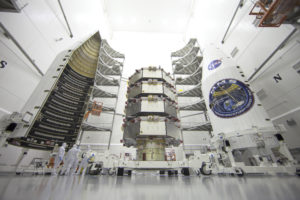
The MMS spacecraft being prepared for launch. Image: NASA
NASA launched the Magnetospheric MultiScale, or MMS, mission on March 12, 2015. MMS consists of four identical spacecraft that orbit around Earth through the dynamic magnetic system surrounding our planet to study a fundamental plasma phenomenon called magnetic reconnection.
The spacecraft carries an extensive suite of instruments measuring electric and magnetic fields and plasma at unprecedented time resolution. A total of eight sensor divided in four sets of Dual Electron Spectrometer (DES) gives a full 3D field-of-view electron distribution in only 30 ms.
Get the data!
The MMS data is publically accessible at the MMS Science Data Center (SDC). Comprehensive analysis packages are available in Matlab (irfu-matlab) and Python (SPEDAS, Space Physics Environment Data Analysis Software).
Related publications lead by team members
- Millisecond observations of nonlinear wave-electron interaction in electron phase space holes
Norgren, C., et al., Physics of Plasmas, vol. 29, no. 1, 2022. doi:10.1063/5.0073097. - Magnetospheric Multiscale Observations of an Expanding Oxygen Wave in Magnetic Reconnection
Håkon Midthun Kolstø, Cecilia Norgren, Michael Hesse, Li-Jen Chen, Paul Tenfjord, Susanne Flø Spinnangr, and Norah Kwagala. Geophysical Research Letters, 48(19):e95065, October 2021. - Electron Acceleration and Thermalization at Magnetotail Separatrices
C. Norgren, M. Hesse, D.B. Graham, Yu.V. Khotyaintsev, P. Tenfjord, A. Vaivads, K. Steinvall, Y. Xu, D.J. Gershman, P.‐A. Lindqvist, F. Plaschke, J.L. Burch. Journal of Geophysical Research: Space Physics, 2020 - Electron reconnection in the magnetopause current layer
Norgren, C., Graham, D. B., Khotyaintsev, Y. V., André, M., Vaivads, A., Hesse, M., et al. (2018). Journal of Geophysical Research: Space Physics, 123.

